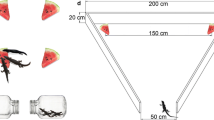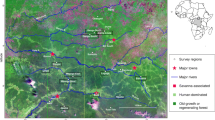Abstract
Flat lizards (Platysaurus broadleyi) at Augrabies Falls National Park, South Africa, are restricted to rocky terrain where the predominant tree is the Namaqua fig (Ficus cordata cordata). P. broadleyi readily feeds on Namaqua figs when they are available, and the lizards sometimes form large (maximum recorded=134) congregations under fruiting fig trees. The distance lizards travel to fruiting trees also exceed normal daily foraging distances. Location of fruiting fig trees by a lizard can have a high pay-off because figs are energetically rich and trees fruit irregularly and asynchronously, resulting in a resource that is available, but unpredictable in time and space. The prediction that bird activity in fig trees provides a cue to the presence of ripe figs was tested experimentally. By placing cages containing birds and empty control cages in trees devoid of fruit, we demonstrated that P. broadleyi are drawn to fig trees with high bird congregations. We also tested if the presence of a fig tree was necessary to draw lizards to bird congregations by placing cages containing birds and empty control cages in a matched-pairs design on rock away from trees. Namaqua fig trees were not necessary to draw lizards to bird congregations.
Similar content being viewed by others
Author information
Authors and Affiliations
Additional information
Received: 12 May 1998 / Accepted after revision: 30 November 1998
Rights and permissions
About this article
Cite this article
Whiting, M., Greeff, J. Use of heterospecific cues by the lizard Platysaurus broadleyi for food location. Behav Ecol Sociobiol 45, 420–423 (1999). https://doi.org/10.1007/s002650050579
Issue Date:
DOI: https://doi.org/10.1007/s002650050579




